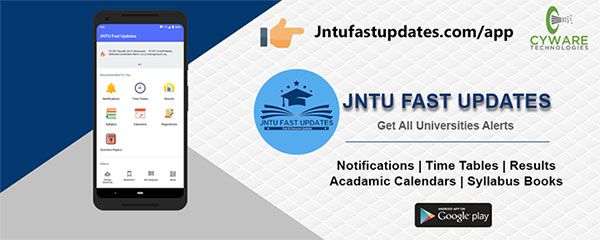JNTUK R20 3-1 Control Systems Material/Notes PDF Download
Students those who are studying JNTUK R20 EEE Branch, Can Download Unit wise R20 3-1 Control Systems (CS) Material/Notes PDFs below.

JNTUK R20 3-1 Control Systems Material/Notes PDF Download
Preamble: This course covers mathematical modeling, time response, frequency response, stability analysis of Linear Time Invariant (LTI) control systems and their analysis. State space analysis of LTI systems and design of compensator using Bode diagrams is also discussed in this course.
OBJECTIVES:
- To learn the mathematical modeling of physical systems and to use block diagram algebra and signal flow graph to determine overall transfer function
- To analyze the time response of first and second order systems and improvement of performance using PI, PD, PID controllers. To investigate the stability of closed loop systems using Routh’s stability criterion and root locus method.
- To understand basic aspects of design and compensation of LTI systems using Bode diagrams.
- To learn Frequency Response approaches for the analysis of LTI systems using Bode plots, polar plots and Nyquist stability criterion.
- To learn state space approach for analysis of LTI systems and understand the concepts of controllability and observability.
UNIT-1
Mathematical Modeling of Control Systems
Classification of control systems – open loop and closed loop control systems and their differences – Feedback characteristics – transfer function of linear system, differential equations of electrical networkstranslational and rotational mechanical systems – transfer function of Armature voltage controlled DC servo motor – block diagram algebra – signal flow graph – reduction using Mason’s gain formula.
UNIT-2
Time Response Analysis and Controllers
Standard test signals – time response of first and second order systems – time domain specifications – steady state errors and error constants – effects of proportional (P) – proportional integral (PI) – proportional derivative (PD) – proportional integral derivative (PID) systems.
Stability Assessment Techniques
The concept of stability – Routh’s stability criterion – limitations of Routh’s stability, root locus concept – construction of root loci (simple problems) – Effect of addition of Poles and Zeros to the transfer function.
UNIT–3
Frequency Response Analysis
Introduction to frequency domain specifications – Bode diagrams – transfer function from the Bode diagram –Polar plots, Nyquist stability criterion- stability analysis using Bode plots (phase margin and gain margin).
Download UNIT-3 Material PDF | Link-2
UNIT–4
Classical Control Design Techniques
Lag, lead, lag-lead compensators – physical realisation – design of compensators using Bode plots.
Download UNIT-4 Material PDF
UNIT–5
State Space Analysis of Linear Time Invariant (LTI) Systems
Concepts of state – state variables and state model – state space representation of transfer function – diagonalization using linear transformation – solving the time invariant state equations – State Transition Matrix and its properties- concepts of controllability and observability.
TEXT BOOKS:
- Modern Control Engineering by Kotsuhiko Ogata, Prentice Hall of India.
- Automatic control systems by Benjamin C.Kuo, Prentice Hall of India,2nd Edition.
REFERENCE BOOKS:
- Control Systems principles and design by M.Gopal, Tata Mc Graw Hill education Pvt Ltd., 4th Edition.
- Control Systems by Manik Dhanesh N, Cengage publications.
- Control Systems Engineering by I.J.Nagarath and M.Gopal, Newage International Publications, 5th Edition.
- Control Systems Engineering by S.Palani,Tata Mc Graw Hill Publications.
OUTCOMES:
- derive the transfer function of physical systems and determination of overall transfer function using block diagram algebra and signal flow graphs.
- determine time response specifications of second order systems and to determine error constants.
- analyze absolute and relative stability of LTI systems using Routh’s stability criterion and the root locus method.
- analyze the stability of LTI systems using frequency response methods.
- design Lag, Lead, Lag-Lead compensators to improve system performance from Bode diagrams.
- represent physical systems as state models and determine the response. Understanding the concepts of controllability and observability.

320-x100(1).gif)

Please
Sir
Only one chance
For
R10 regulation.
Unit 4 link was not given